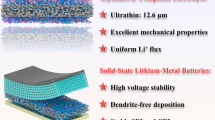Abstract
Three-dimensional ZnO nanorod arrays on flexible high surface area carbon cloth were successfully synthesized and directly used as negative electrodes for lithium-ion batteries without using any binder additive. The structure and morphology of the as-prepared hybrid ZnO electrode were characterized by X-ray diffraction (XRD), scanning electron microscopy (SEM), and high-resolution transmission electron microscopy (HRTEM). When tested as anodes in a lithium cell, the hybrid electrode demonstrated a high discharge capacity along with excellent rate capability and good cycling stability, delivering a reversible capacity of 891 mAh g−1 at the second cycle and retaining a capacity of 469 mAh g−1 after 100 cycles.







Similar content being viewed by others
References
Ahmad M, Shi Y, Nisar A, Sun H, Shen W, Wei M, Zhu J (2011) Synthesis of hierarchical flower-like ZnO nanostructures and their functionalization by Au nanoparticles for improved photocatalytic and high performance Li-ion battery anodes. J Mater Chem 2011:7723–7729
Belliard F, Irvine JTS (2001) Electrochemical performance of ball-milled ZnO–SnO 2, systems as anodes in lithium-ion battery. J Power Sources 97-98(7):219–222
Chen Y, Liu B, Jiang W, Liu Q, Liu J, Wang J, Zhang H, Jing X (2015) Coaxial three-dimensional CoMoO4 nanowire arrays with conductive coating on carbon cloth for high-performance lithium ion battery anode. J Power Sources 300:132–138
Fu ZW, Feng H, Ye Z, Yue C, Qin QZ (2003) The electrochemical reaction of zinc oxide thin films with lithium. J Electrochem Soc 150:A714–A720
Greene LE, Law M, Tan DH, Montano M, Goldberger J, Somorjai G, Yang P (2005) General route to vertical ZnO nanowire arrays using textured ZnO seeds. Nano Lett 5:1231–1236
Hieu NS, Lim JC, Lee JK (2012) Free-standing silicon nanorods on copper foil as anode for lithium-ion batteries. Microelectron Eng 89:138–140
Huang XH, Xia XH, Yuan YF, Zhou F (2011) Porous ZnO nanosheets grown on copper substrates as anodes for lithium ion batteries. Electrochim Acta 56:4960–4965
Li H, Wei Y, Zhang Y, Yin F, Zhang C, Wang G, Bakenov Z (2016a) Synthesis and electrochemical investigation of highly dispersed ZnO nanoparticles as anode material for lithium-ion batteries. Ionics 22:1387–1393
Li H, Wei Y, Zhao Y, Zhang Y, Yin F, Zhang C, Bakenov Z (2016b) Simple one-pot synthesis of hexagonal ZnO nanoplates as anode material for lithium-ion batteries. J Nanomater 2016:4675960
Lou F, Zhou H, Vullum-Bruer F, Tran TD, Chen D (2013) Synthesis of carbon nanofibers@MnO2 3D structures over copper foil as binder free anodes for lithiumi on batteries. J Energy Chem 22:78–86
Park KT, Xia F, Kim SW, Kim SB, Song T, Paik U, Park WI (2013) Facile synthesis of ultrathin ZnO nanotubes with well-organized hexagonal nanowalls and sealed layouts: applications for lithium ion battery anodes. J Phys Chem C 117:1037–1043
Pan GX, Xia XH, Cao F, Chen J, Zhang YJ (2014) Carbon cloth supported vanadium pentaoxide nanoflake arrays as high-performance cathodes for lithium ion batteries. Electrochim Acta 149:349–354
Poizot P, Laruelle S, Grugeon S, Dupont L, Tarascon JM (2000) ChemInform abstract: nano-sized transition-metal oxides as negative-electrode materials for lithium-ion batteries. Nature 407:496–499
Wang B, Wang G, Zheng Z, Wang H, Bai JT, Bai JB (2013) Carbon coated Fe3O4 hybrid material prepared by chemical vapor deposition for high performance lithium-ion batteries. Electrochim Acta 106:235–243
Wang Z, Luan D, Boey FY, Lou XW (2011) Fast formation of SnO2 nanoboxes with enhanced lithium storage capability. J Am Chem Soc 133:4738–4741
Wang Z, Luan D, Madhavi S, Hu Y, Lou XW (2012) Assembling carbon-coated α-Fe2O3 hollow nanohorns on the CNT backbone for superior lithium storage capability. Energy Environ Sci 5:5252–5256
Wang L, Tang K, Zhang M, Xu J (2015) Facile synthesis of Mn-doped ZnO porous nanosheets as anode materials for lithium ion batteries with a better cycle durability. Nanoscale Res Lett 10:1–5
Wang H, Pan Q, Cheng Y, Zhao J, Yin G (2009) Evaluation of ZnO nanorod arrays with dandelion-like morphology as negative electrodes for lithium-ion batteries. Electrochim Acta 54:2851–2855
Wang X, Huang L, Zhao Y, Zhang Y, Zhou G (2016) Synthesis of mesoporous ZnO nanosheets via facile solvothermal method as the anode materials for lithium-ion batteries. Nanoscale Res Lett 11:37
Woo MA, Kim TW, Kim IY, Hwang SJ (2011) Synthesis and lithium electrode application of ZnO-ZnFe2O4 nanocomposites and porously assembled ZnFe2O4 nanoparticles. Solid State Ionics 182:91–97
Xie Q, Zhang X, Wu X (2014) Yolk-shell ZnO-C microspheres with enhanced electrochemical performance as anode material for lithium ion batteries. Electrochim Acta 125:659–665
Xie X, Kretschmer K, Zhang J, Sun B, Su D, Wang G (2015) Sn@CNT nanopillars grown perpendicularly on carbon paper: a novel free-standing anode for sodium ion batteries. Nano Energy 13:208–217
Xue XY, Chen ZH, Xing LL, Yuan S, Chen YJ (2011) SnO2/α-MoO3 core-shell nanobelts and their extraordinarily high reversible capacity as lithium-ion battery anodes. Chem Commun 47:5205–5207
Yu J, Du N, Wang J, Zhang H, Yang D (2013) SiGe porous nanorod arrays as high-performance anode materials for lithium-ion batteries. J Alloys Compd 577:564–568
Zhou M, Hu Y, Liu Y, Yang W, Qian H (2012) Microwave-assisted route to fabricate coaxial ZnO/C/CdS nanocables with enhanced visible light-driven photocatalytic activity. CrystEngComm 14:7686–7693
Acknowledgements
The authors acknowledge the financial support from the NSFC Grant No. 21406052, 51602111, Guangdong Province Grant NO. 2014B090914004, 2014B090915005, 2015A030310196, 2015B050501010, 14KJ13, the Program for the Outstanding Young Talents of Hebei Province (Grant No. BJ2014010), the Pearl River S&T Nova Program of Guangzhou (201506040045), PCSIRT Project No. IRT13064 and Scientific Research Foundation for Selected Overseas Chinese Scholars, Ministry of Human Resources and Social Security of China (Grant No. CG2015003002). ZB acknowledges the financial support by the grants from the Ministry of Education and Science of Kazakhstan #5097/GF and 5687/GF.
Author information
Authors and Affiliations
Corresponding authors
Ethics declarations
Conflict of interest
The authors declare that they have no conflict of interest.
Rights and permissions
About this article
Cite this article
Huang, L., Wang, X., Yin, F. et al. Three-dimensional carbon cloth-supported ZnO nanorod arrays as a binder-free anode for lithium-ion batteries. J Nanopart Res 19, 42 (2017). https://doi.org/10.1007/s11051-017-3742-9
Received:
Accepted:
Published:
DOI: https://doi.org/10.1007/s11051-017-3742-9




